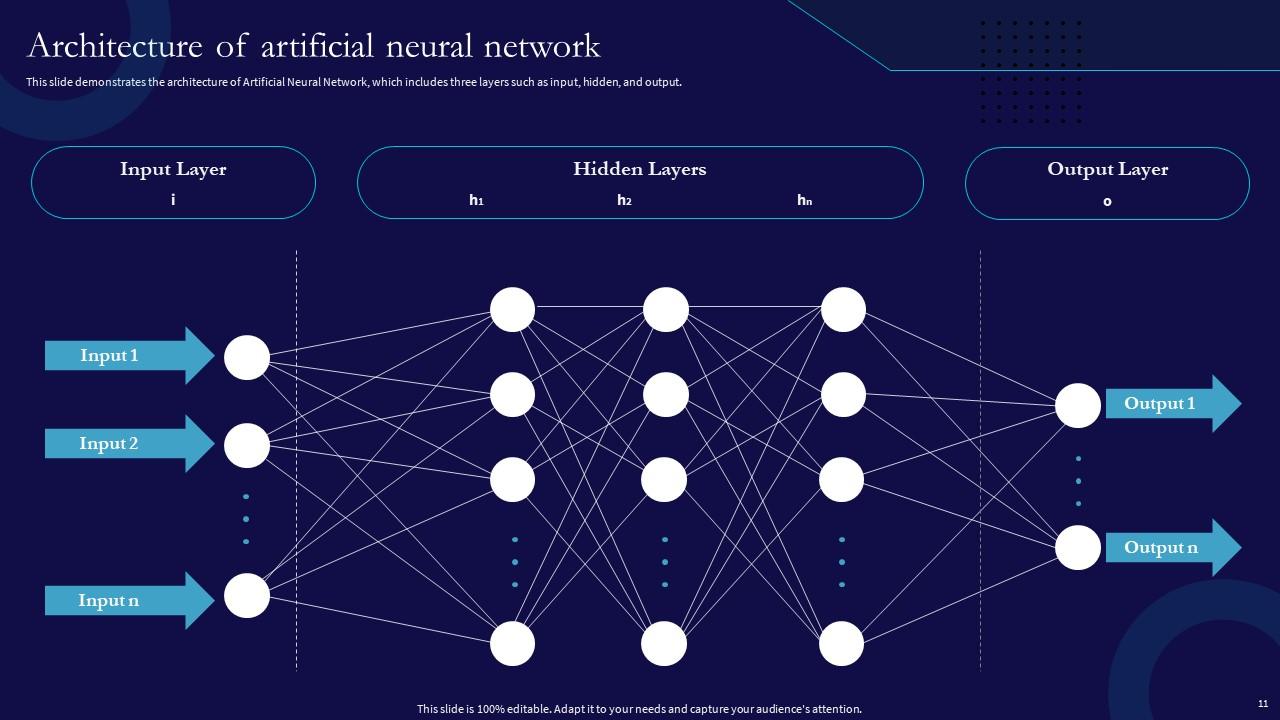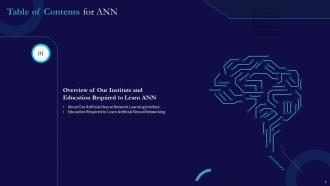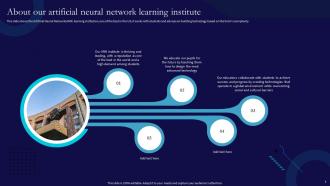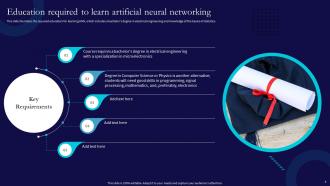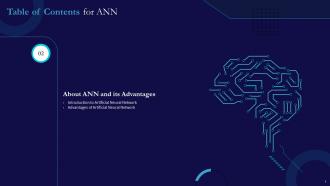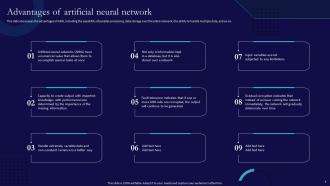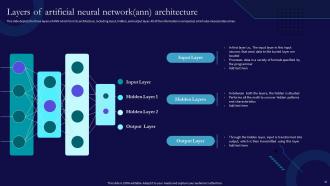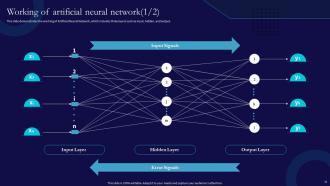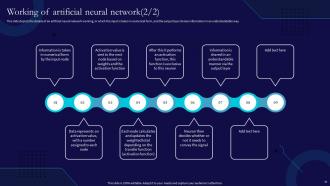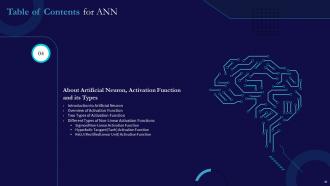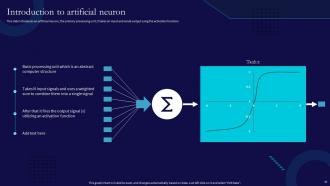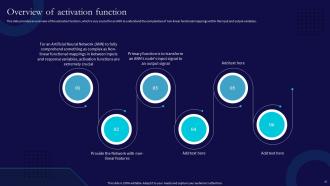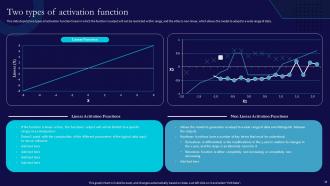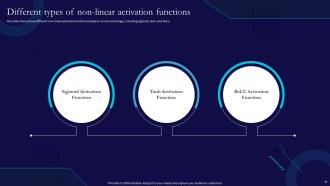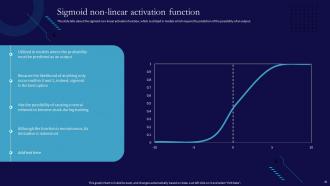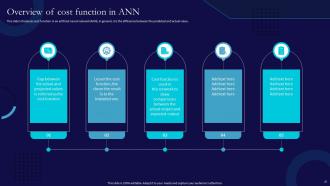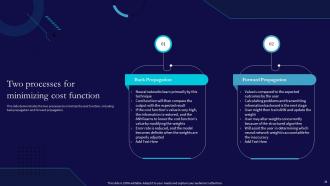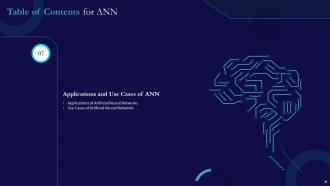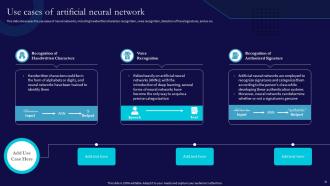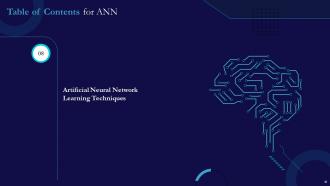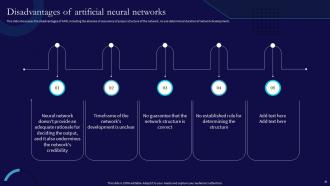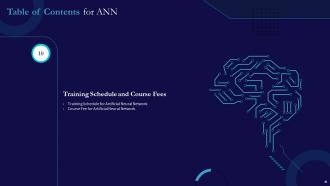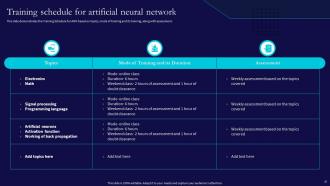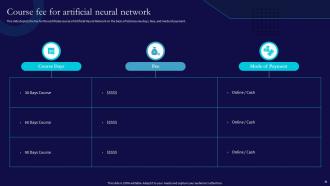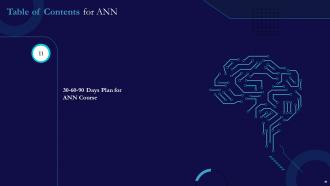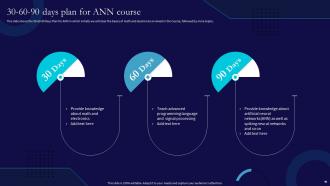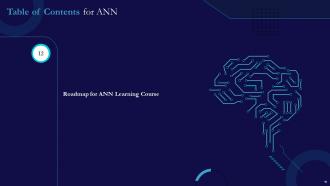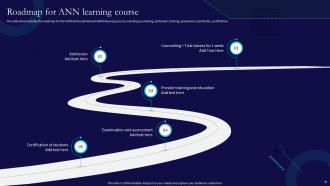ANN Powerpoint Presentation Slides
ANNs are sophisticated computer programs that draw inspiration from human biological systems. Check out our insightfully designed template on ANN. It helps in Recognizing business trends, collaborating with teams to learn, and forecasting future data are their significant responsibilities. Our Artificial Neural Networks template introduces the ANN learning institute, its significance, and benefits. The institutes overview and the education needed to learn ANN are both shown in this PowerPoint Presentation. It also provides information about ANN and its benefits. Additionally, Our ANN deck demonstrates the layers and operational patterns of artificial neural networks. It also teaches about Artificial Neural Network Learning Techniques, including activation functions, types, and cost functions. The application and use case of ANN, learning methodologies, details for the two processes to minimize the cost function, and other information are also illustrated in this effective template. Lastly, it emphasizes the drawbacks of ANN, the training schedule and course costs, the 30 60 90 day course schedule, and the road map. Get access to this powerful template now.
- Google Slides is a new FREE Presentation software from Google.
- All our content is 100% compatible with Google Slides.
- Just download our designs, and upload them to Google Slides and they will work automatically.
- Amaze your audience with SlideTeam and Google Slides.
-
Want Changes to This PPT Slide? Check out our Presentation Design Services
- WideScreen Aspect ratio is becoming a very popular format. When you download this product, the downloaded ZIP will contain this product in both standard and widescreen format.
-

- Some older products that we have may only be in standard format, but they can easily be converted to widescreen.
- To do this, please open the SlideTeam product in Powerpoint, and go to
- Design ( On the top bar) -> Page Setup -> and select "On-screen Show (16:9)” in the drop down for "Slides Sized for".
- The slide or theme will change to widescreen, and all graphics will adjust automatically. You can similarly convert our content to any other desired screen aspect ratio.
Compatible With Google Slides

Get This In WideScreen
You must be logged in to download this presentation.
PowerPoint presentation slides
Enthrall your audience with this ANN Powerpoint Presentation Slides. Increase your presentation threshold by deploying this well-crafted template. It acts as a great communication tool due to its well-researched content. It also contains stylized icons, graphics, visuals etc, which make it an immediate attention-grabber. Comprising forty eight slides, this complete deck is all you need to get noticed. All the slides and their content can be altered to suit your unique business setting. Not only that, other components and graphics can also be modified to add personal touches to this prefabricated set.
People who downloaded this PowerPoint presentation also viewed the following :
Content of this Powerpoint Presentation
Slide 1: This slide introduces ANN. Commence by stating Your Company Name.
Slide 2: This slide depicts the Agenda of the presentation.
Slide 3: This slide elucidates the Table of contents.
Slide 4: This slide highlights the Title for the Topics to be covered in the next template.
Slide 5: This slide shows the Artificial Neural Network(ANN) learning institution, one of the best in the US; it works with students and advises on building technology based on the brain's complexity.
Slide 6: This slide illustrates the required education for learning ANN, which includes a bachelor's degree in electrical engineering and knowledge of the basics of statistics.
Slide 7: This slide mentions the Heading for the Components to be discussed further.
Slide 8: This slide provides an overview of ANN, the network similar to the human brain; dendrites represent inputs, nodes represent the cell nuclei, and so on.
Slide 9: This slide showcases the advantages of ANN, including the capability of parallel processing, data storage over the entire network, the ability to handle multiple data, etc.
Slide 10: This slide reveals the Title for the Ideas to be covered further.
Slide 11: This slide demonstrates the architecture of Artificial Neural Network, which includes three layers such as input, hidden, and output.
Slide 12: This slide depicts the three layers of ANN which form its architecture, including input, hidden, and output layer.
Slide 13: This slide displays the working of Artificial Neural Network, which includes three layers such as input, hidden, and output.
Slide 14: This slide continues the Working of artificial neural network.
Slide 15: This slide reveals the Heading for the Ideas to be discussed in the upcoming template.
Slide 16: This slide introduces an artificial neuron, the primary processing unit; it takes an input and sends output using the activation function.
Slide 17: This slide provides an overview of the activation function, which is very crucial for an ANN to understand the complexities of non-linear functional mappings within the input and output variables.
Slide 18: This slide depicts two types of activation function linear in which the function's output will not be restricted within range, and the other is non-linear, which allows the model to adapt to a wide range of data.
Slide 19: This slide shows three different non-linear activation functions based on curves and ranges, including sigmoid, tanh, and ReLU.
Slide 20: This slide talks about the sigmoid non-linear activation function, which is utilized in models which require the prediction of the possibility of an output.
Slide 21: This slide presents the tanh Activation Function ranging from -1 to 1, and both tanh and sigmoid are used in feedforward networks.
Slide 22: This slide demonstrates the rectified linear unit activation function, which is the most utilized function in the current world and is both derivative and monotonic.
Slide 23: This slide portrays the Title for the Components to be covered next.
Slide 24: This slide shows feedforward, one of the types of Artificial Neural Networks(ANN) in this; signals can go in only one way, and outputs of the previous layer become the input of the next one.
Slide 25: This slide depicts the feedback network, which is the other type of ANN; this contains feedback loops; in this, neurons, just like the brain, it can have any number of connections.
Slide 26: This slide mentions the Heading for the Topics to be covered next.
Slide 27: This slide introduces cost function in an artificial neural network(ANN); in general, it is the difference between the predicted and actual value.
Slide 28: This slide demonstrates the two processes to minimize the cost function, including backpropagation and forward propagation.
Slide 29: This slide highlights the Title for the Topics to be covered further.
Slide 30: This slide represents the applications of artificial neural networks such as paraphrase detection, forecasting, image processing, and so on.
Slide 31: This slide showcases the use cases of neural networks, including handwritten characters recognition, voice recognition, detection of fraud signatures, etc.
Slide 32: This slide indicates the Title for the Topics to be covered in the upcoming template.
Slide 33: This slide illustrates the two types of ANN techniques, including learning under supervision, and learning without supervision.
Slide 34: This slide outlines the Heading for the Components to be discussed further.
Slide 35: This slide shows the disadvantages of ANN, including the absence of assurance of proper structure of the network, no pre-determined duration of network development.
Slide 36: This slide indicates the Title for the Topics to be covered next.
Slide 37: This slide demonstrates the Training Schedule for ANN based on topics, mode of training and its training, along with assessment.
Slide 38: This slide depicts the fee for the certificate course of Artificial Neural Network on the basis of total course days, fees, and mode of payment.
Slide 39: This slide mentions the Heading for the Contents to be covered further.
Slide 40: This slide shows the 30-60-90 Days Plan for ANN course.
Slide 41: This slide elucidates the Title for the Components to be discussed next.
Slide 42: This slide portrays the roadmap for the Artificial Neural Network(ANN) learning course.
Slide 43: This is the Icons slide containing all the Icons used in the plan.
Slide 44: This slide is used to depict Additional information.
Slide 45: This slide represents the vision, mission & goal of the Company.
Slide 46: This slide incorporates the Bar chart.
Slide 47: This slide contains the Post it notes for reminders and deadlines.
Slide 48: This is the Thank You slide for acknowledgement.
ANN Powerpoint Presentation Slides with all 53 slides:
Use our ANN Powerpoint Presentation Slides to effectively help you save your valuable time. They are readymade to fit into any presentation structure.
FAQs
An Artificial Neural Network (ANN) is a type of computational model that is inspired by the structure and function of the human brain. It consists of interconnected nodes that work together to process and analyze complex data.
Some advantages of using an ANN include parallel processing, data storage over the entire network, the ability to handle multiple data, and the ability to learn and adapt over time.
An ANN consists of three layers: input, hidden, and output. The input layer receives data, the hidden layer processes the data, and the output layer produces the results.
An activation function in an ANN is a mathematical function that determines the output of a neuron based on its input. It is crucial for the ANN to understand the complexities of non-linear functional mappings within the input and output variables.
ANN can be used for various applications, including paraphrase detection, forecasting, image processing, handwriting recognition, voice recognition, fraud detection, and so on.
-
Definitely a time saver! Predesigned and easy-to-use templates just helped me put together an amazing presentation.
-
Excellent products for quick understanding.












